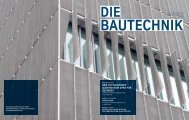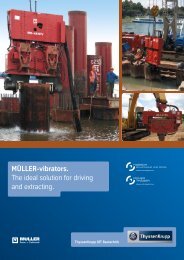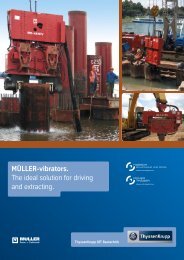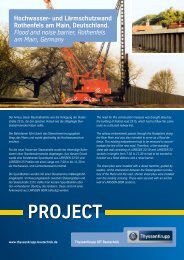NeW THYSSeNKRUPP QUaRTeR NOW OPeN FOR BUSINeSS
NeW THYSSeNKRUPP QUaRTeR NOW OPeN FOR BUSINeSS
NeW THYSSeNKRUPP QUaRTeR NOW OPeN FOR BUSINeSS
Create successful ePaper yourself
Turn your PDF publications into a flip-book with our unique Google optimized e-Paper software.
26 IN BRIeF<br />
The stabilisation with TITAN 30/11 injection piles<br />
counteracts the differential deformations in the problem<br />
zones at transitions.<br />
STABILISATION<br />
MEASURES WITH<br />
INJECTION PILES<br />
TITaN injection pile<br />
applications for<br />
Deutsche Bahn:<br />
• Foundation elements for DB<br />
overhead line masts<br />
• Reinforcing elements for<br />
retaining walls/piers<br />
• Noise barriers<br />
• Tunnel nailing<br />
• Embankment stabilisation<br />
• Slope stabilisation<br />
In addition to talking about the use of injection piles on<br />
Deutsche Bahn AG projects for improving the permanent way<br />
and reducing settlement of railway embankments, Dipl.-Ing.<br />
Godehard Drees also explained the advantages of bridge<br />
abutments in the form of sheet pile walls with knife-edge<br />
bearing.<br />
TITAN 30/11 injection piles can be used to improve the<br />
permanent way and reduce the settlement of railway<br />
embankments. Underbridges represent a new application<br />
for injection piles. The transitions between earthworks and<br />
underbridge structures are always problem zones because<br />
of the different stiffnesses and deformations. Bodies of soil<br />
are always much more willing to deform than the relatively<br />
rigid bridge or tunnel structures. That results in differential<br />
settlement which leads to inconsistencies in the railway<br />
track. Such undesirable settlement becomes more and more<br />
critical for train operations as the running speeds increase.<br />
More repairs and maintenance are necessary.<br />
One way of substantially reducing this settlement at the soilstructure<br />
interface without impairing rail traffic is to stabilise<br />
the subsoil with injection piles. This method has been carried<br />
out in Spain with great success and has proved itself as a<br />
technique for improving the permanent way. Depending on the<br />
size of the embankment, between 15 and 20 injection piles<br />
are installed in the wedge-shaped transition zone in 2–4<br />
layers, some 2–3 m apart. The injection piles can considerably<br />
reduce the tamping processes necessary in the track.<br />
Summary: Trains can travel faster and the costs of repairs and<br />
maintenance are lower. An innovative, simple method for<br />
improving the permanent way and allowing trains to run faster.<br />
How TITaN injection piles work<br />
Steel tendons in individual lengths of max. 3 m are screwed<br />
together and drilled into the ground to the required depth<br />
with the help of a flushing fluid, which stabilises the hole.<br />
Pressure grouting begins once the design depth has been<br />
reached. The drill rotates without drilling deeper and the<br />
pressure grouting begins. During the pressure grouting, the<br />
flushing fluid, which supports the sides of the hole, is replaced<br />
by the stiff grout suspension (w/c ratio ~ 0.8 at 5–20 bar).<br />
After it has cured, the body of injected grout together with the<br />
soil reaches a final strength corresponding to concrete grade<br />
B 25 at least.<br />
IN BRIeF 27<br />
Settlement in the wedge-shaped<br />
transition zone can be kept in check<br />
by means of injection piles.
















